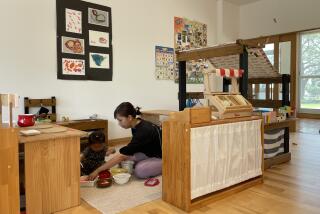High-Tech Bedroom May Be a Dream Come True for Sleep-Deprived Japanese
- Share via
Nearly every waking hour of Japanese life is imbued with high-tech gadgetry. Soon the sleeping hours might be too.
Matsushita Electric Works, a Tokyo company that manufactures home appliances and building materials, has developed a fully automated, computer-controlled “sleeping environment” -- a bedroom tricked out with cutting-edge lighting, audio and video systems, a massaging mattress and vents that control not only the temperature in the room but also the oxygen level as well.
Why is this necessary? Because, project manager Ryoji Nakajima says, the fast pace of modern Japanese life is stressing people out.
“One-third of the people here have sleeping problems,” Nakajima said.
The frazzled insomniac need touch only a button for the sleep-inducing cycle to begin. The bed slowly unfolds from a sitting to flat position. Curtains close, lights dim, calming nature scenes appear on a 42-inch plasma screen, and the room fills with the sound of rustling leaves and other noises from nature.
About 10 minutes later, small air pockets throughout the mattress begin inflating and deflating to produce a gentle rocking motion. The room lights slowly oscillate in a soothing pattern as the plasma screen goes dark.
“By now, we hope they are ready for sleep,” Nakajima said.
As the weary Japanese slumbers, the temperature in the sleep environment is slightly elevated and the nature soundtrack continues at a low level to block outside noises.
When it’s time to wake up, the lights gradually become brighter, the curtains open and pictures of sunrises and other morning scenes appear on the TV. In case that’s not suggestive enough, the mattress commences a more vigorous massage motion and the oxygen level in the room is raised from 22%, which is normal, to 30%.
“It’s refreshing,” Nakajima said.
This high-tech version of counting sheep was developed with the help of sleep scientists and will go into production next year. The price tag, Nakajima said, will probably be about $25,000.
Frisca Yan-Go, medical director of the UCLA Sleep Disorders Center, said the principles behind the sleep environment were mostly valid. But the hefty price would keep her up at night.
Besides, she said, most sleep irregularities have little to do with the environment. “Most of it is within ourselves,” Yan-Go said.
The system debuted in Matsushita’s Tokyo showroom only last month, so it’s too soon to say whether the company has a sleeper hit on its hands. The sleep environment is currently being tested by housing developers and condominium builders who might want to offer it in their dwellings. But no slumber parties; the demonstrations last only 25 minutes.
Even Nakajima, who spent more than a year overseeing the development of the project, has yet to spend a night in the room. Which is a shame, because he is one of the many Japanese who has developed a sleep problem.
But he can pinpoint the reason: “It is because of this room.”
More to Read
Inside the business of entertainment
The Wide Shot brings you news, analysis and insights on everything from streaming wars to production — and what it all means for the future.
You may occasionally receive promotional content from the Los Angeles Times.











